The 11th Art of Record Production Conference

The 11th Art of Record Production conference was held at Aalborg University December 2-4 2016. The Unheard Sounds Project, with myself and NTNU colleague Trond Engum, was represented with the presentation More Unheard Sounds - technique, creativity and application of transposed ultrasound.
The presentation was a follow-up of our previous presentation at the ARP2014 conference in Oslo, where we presented the project for the first time. That presentation also resulted in a publication in the Journal of the Art of Record Production, JARP, issue 10, 2015 (read it here).
At this conference we presented results of our latest recording sessions in the studio, using equipment that allowed for recordings up to 96kHz, of conventional instruments like violin, alto saxophone, double bass, flute, piccolo flute, percussion and female vocals (Carl Haakon Waadeland, Tone Åse, Trine Knutsen and Michael Duch were among the performers). We demonstrated the principle that higher effort/energy results in larger amounts of ultrasonic content, but could also show that more ideosyncratic aspects of instruments and playing techniques could play a part.
We rounded off our presentation with a short demo-performance applying the sounds we had recorded. Trond used a setup where the samples with ultrasonic content had been pre-transposed and integrated into his playing setup using convolution (with electric guitar) and granular processing, among other things. I had a setup where a piece of plywood with two contact microphones drove a system (written in Csound) where the samples were transposed and combined in real-time. One of the conference participants, Daniel Pratt, was so kind as to record the performance on his phone (thanks a lot, Daniel!), and you can see the performance here:
Unheard Sounds: ARP2016 demo/performance from Andreas Bergsland on Vimeo.
Article in SoundEffects Journal

SoundEffects is an open access, international, peer-reviewed journal on sound and sound experience operating on the Open Journal System. The latest issue (vol 6, no.1) has an article written by me and Robert Wechsler entitled "Turning movement into music: Issues and applications of the MotionComposer, a therapeutic device for persons with different abilities".
Abstract:
The article discusses the ways in which the MotionComposer (MC), a newly developed device that turns movement into music, engages users with different abilities, so as to provide positive psychological and somatic effects. It begins with a case study; the story of one application of the device involving a young man with cerebral palsy. His experiences are typical of many others and provide some useful generalisations. The article then discusses a number of goals and related design principles that have been important in the development of the device, including a discussion of two conflicting strategies which must be reconciled: On the one hand, there is a need for clear causality. On the other hand, for such a device to remain interesting over time, there is a need for variation. A technical description of the hardware and software is given, followed by a discussion of general mapping issues pertaining to the different sound environments or interaction modes of the MC.Read the article here.
International Symposium on Digital Humanities: Panel presentation
During the symposium myself and Thomas Sørlie Hansen represented NTNU when our university was accepted as a member of the Nordic Hub of DARIAH-EU (Digital Research Infrastructure for the Arts and Humanities) alongside Aarhus, Helsinki and Linnäus universities.
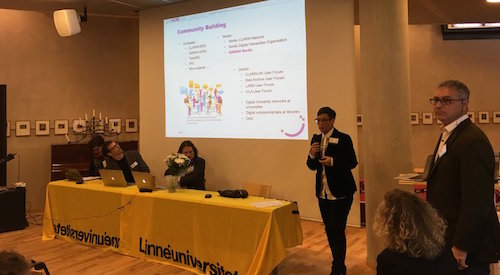
Photo: Marianne Ping Huang presenting Aarhus' infrastructure related to the digital humanities. (Posted by MediaTech@LNU on Twitter, URL)
Book chapter: Høyblokka - post mortem

I am really happy to announce that the book about the Tower Block Project is now published on Novus forlag (in Norwegian): Høyblokka - post mortem. Teater som ritual. (Rønning & Fyhn, eds.). Høyblokka - post mortem was a research based art project - or perhaps an art based research project - revolving around the process of demolition of Trondheim's hospital. As the web-site explains:
"In 2011 the old city hospital in Trondheim - a gigantic 12 store tower block - was demolished, giving space for a new modern hospital. With it, an emotional land mark in the city has disappeared, as this tower block was the location of memories of birth, death, crisis and healing for a lot of people in Trondheim. We collected many of these memories through a memory blog. This blog founded the basis for the production of a performance, or rather a ritual, serving as a funeral for the Tower block, held in the midst of its ruins." (http://hoyblokka.no/eng.php, accessed 21.12.2016).
My main contribution to the project was primarily as composer of electroacoustic compositions, but in the early stages of the project I also made the audio-visual work Minne fra et tomt rom featuring Håkon Fyhn telling a memory of his last meeting with his grandfather. (See it on youtube here). The chapter that is my contribution is entitled "No e æ i det rommet..." - Minner, resonans og etterklang ("Now I am in that room..." - Memories, resonance and reverberation) and contains reflections around that audio-visual work.
Barbro Rønning, Håkon Fyhn and myself presented the book at Sakprosafestivalen (festival for factual prose) in Trondheim November 25. (See the program here).
Voice in Norwegian electroacoustic music - panel
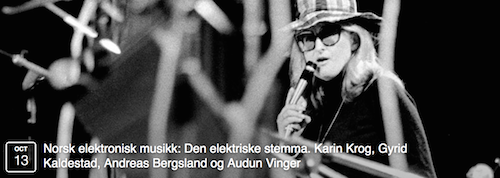
Together with Norway's perhaps most renowned jazz singer Karin Krog, experimental vocalist and live-electronics performer Gyrid Kaldestad, and journalist Audun Vinger, I was invited to a panel discussion about voice in Norwegian electroacoustic music, hosted by the National Library (Nasjonalbiblioteket) and taking place on October 13.
My role in the panel was primarily to provide a research perspective on the topic. I started by setting up an historical context and introducing some over-all categories to discern central issues in the field. Subsequently Karin presented a number of examples that showed her central role in the scene from early on, utilizing live-treatments and tape manipulation already back in the 60s. Gyrid then presented her take on the field with examples from her work.
The highlight of the evening for me was when Karin corrected a misconception about her contribution in the performance of Arnold, by Gunnar Sønstevold, where she was credited as "voice": "It was me playing the ring modulator, not Arne [Nordheim, who is credited on the Popofoni record on which the composition was published]. My opening presentation can be read here (in Norwegian). My intentions are to write an article about the topic during 2017.
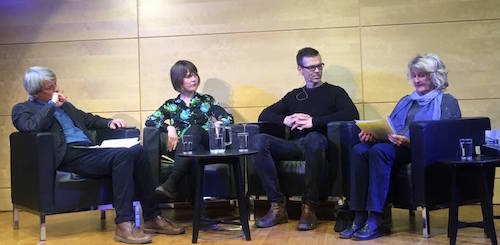
Panel about voice in Norwegian Electroacoustic music with voice at Nasjonalbiblioteket: Audun Vinger, Gyrid Kaldestad, Andreas Bergsland and Karin Krog (Photo: Mirjam Dahl Bergsland).
Sessions with Cross Adaptive project
The project Cross adaptive processing as musical intervention, led by my colleague Øyvind Brandtsegg at NTNU, started up this summer and I was invited to join in the project as an observer and organizer of video-documentaion. The project blog describes the main ideas behind the project:"The project explores cross-adaptive processing as a drastic intervention in the modes of communication between performing musicians. Digital audio analysis and processing techniques are used to enable features of one sound to inform the processing of another. This allows the actions of one performer to directly influence another performer's sound, and doing so only by means of the acoustic signal produced by normal musical expression on the instrument." (http://crossadaptive.hf.ntnu.no/).
I have written a blog post about my work of organizing software/hardware solutions for multi-camera recording and live-streaming of the project session that can be read here. The work made med explore tools like ffmpeg and Processing, but in the end two pieces of easy-to-use freeware, IP Camera Viewer and Open Broadcaster Softeware (OBS), turned out to be the best solutions.
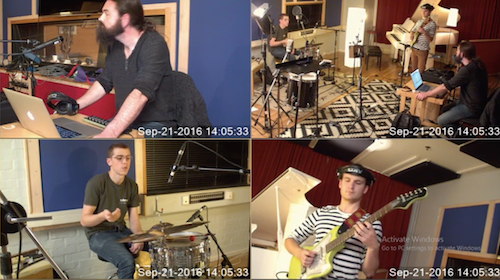
Screenshot from a multi-camera live-streaming broadcast of Cross Adaptive session with students from the jazz performance program at NTNU September 21 2016.
Performance and workshop at Changes?!, Salzburg

I was very happy to be invited to Changes?!, the 9th international Orff Schulwerk Symposium in Salzburg, July 2016 together with MotionComposer colleague Robert Wechsler to do a performance and a workshop. The performance took place at the studio hall in the Mozarteum. We had one half of an evening show dedicated to us, with the first half by Xala, a remarkable duet consisting of a percussionist and Ania Losinger playing a custom made marimba-like instrument that she played with tap-dancing shoes and long sticks.
In our half, Robert performed a piece by Pablo Palacio, and with help from two local dancers, Marina and Saskia, we showed several solos with the Particles environment. My personal highlight was the premiere of my brand new piece, played on a piece of plywood with a contact mic attached to it. The piece consisted of several different states with transitions in between, and Robert and the two dancers had coreographed their own dance sequence to the piece. The whole performance was live-streamed on YouTube, but I also hope to get a copy of the recording to present here in the near future. The concert program can be found here.
The next day, we held two workshops presenting the MotionComposer at the Orff institute with participants from all over the world including Taiwan, Iran, Serbia, China and Italy. Several of the participants had interesting ideas to the further development of the device.
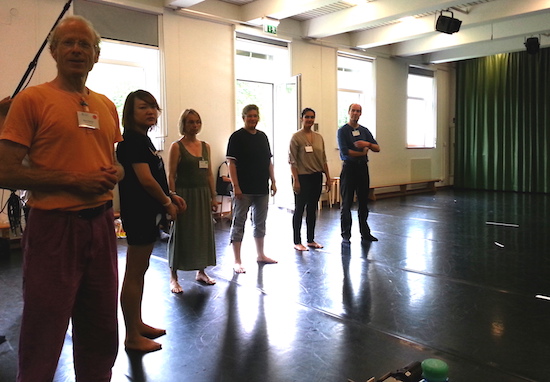
Robert Wechsler with participants at a MotionComposer workshop at the Orff institute.
Porto International Conference on Musical Gesture as Creative
Interface

Together with Robert Wechsler I had a presentation accepted for the Musical Gestures as Creative Interdace entitled "MotionComposer - a device for persons with (and without) disabilities. Any gesture can be musical. Affording difference in musical interaction design". The conference was hosted by CITAR, Centro de Investigacão em Ciência e Tecnologia das Artes Universidade Catolica Portuguesa in Porto, Portugal. Due to different reasons I was unable to attend at the conference, but fortunately Robert could make it, and held the presentation as scheduled. The whole programme can be downloaded here, but for a shortcut to our abstract, choose this link.
Special Recognition Award in Guthman Competition
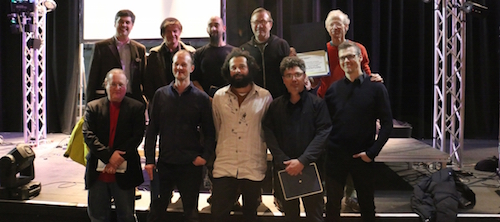
The MotionComposer, represented by me, Robert Wechsler and performer Eric Naindouba, received the Special Recognition Award in the Guthman Musical Instrument Competition 2016. We were among nine finalists who got to present their instruments at the Ferst Centre for the Arts in front of a couple hundred people and the three judges, Pat Metheny, Marcello Wanderley and Allan Kozinn. The amazing Ken Butler won first prize with his arsenal of instruments, which were mostly made from junk like an old golf club, hockey stick, tennis racket, toothbrush, and much more.
We were really happy to collaborate with another amazing performer, Eric Naindouba, a boy of 12 years with severe cerebral palsy, originally from the Central African Republic, from which he fled with his mother to the US several years ago. Eric took the crowd by storm with his musicality and sense of form. His first response after his performance was "More!". We are hoping that we in collaboration with Tools for Life, Georgia's Assistive Technology Act Program, in time can give Eric the chance to play the MotionComposer on a regular basis. Wheat Williams has written a review of the Guthman Competition finals on his blog. Read it here.
The whole competition concert was recorded and you can see the video here:
Lecture on the music technology of pop at Ringve
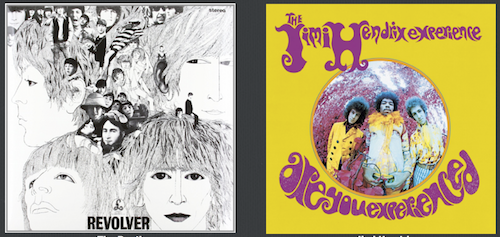
As a part of the Music Technology Program's collaboration with Ringve Museum for Musical Instruments, I gave a public lecture on the music technology of pop the 19th of February. The lecture focused on how new music technology profoundly shaped popular music in the two-three decades after the Second World War. The focus was on two new musical instruments, the electric guitar and the synthesizer, as well as the new recording media (LPs, 45s, cassettes and 8 track), and new creative and manipulative practices with magnetic tape and electronic sound effects. The slides from the lecture can be downloaded here (in Norwegian).

